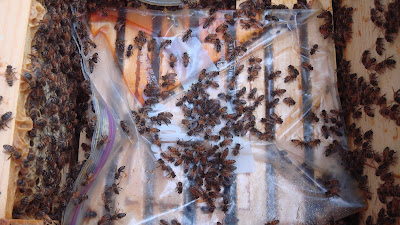is my
spelling error! Horrors!
I have been appalled that "ginormous" is now a word that is accepted and is in the dictionary. I certainly don't want to supply any more terrible contributions to the English language, so I want to do my part to rectify an error.
Dr. Paul Arnold is a "Palynologist" not whatever I labeled him earlier (not writing it again to avoid continuing the trend in the ginormous direction.)
OK, so let's look at the word. Wikipedia says
"Palynology is the science that studies contemporary and fossil palynomorphs, including pollen, spores, dinoflagellate cysts, acritarchs, chitinozoans and scolecodonts, together with particulate organic matter (POM) and kerogen found in sedimentary rocks and sediments. Palynology does not include diatoms, foraminiferans or other organisms with silicaceous or calcareous exoskeletons."I heard from Dr. Arnold today about the analysis of my pollen sample. Here is what he said:
"Sorry it has taken me so long to look at your specimen! You had what seemed to be quite a bit of tulip poplar, and some magnolia pollen. Also, quite a bit of rosaceous pollen was found in your specimen (possibly blackberry, strawberry, apple, etc.). Holly pollen was also present in pretty large amounts, as was another very large pollen grain which I have not seen before. I keyed it out through my pollen keys, and it seemed to lead me to either a type of lily or yucca plant. I’m not 100% sure about this last grain, since I have never made a reference slide of yucca, but I wouldn’t rule that possibility out. All in all, a pretty typical spring woodland honey (with the exception of that last grain)."
I wrote back that this super was filled by the bees in early July - actually late June/early July.
Here's his response (what a nice guy - he ran my specimen again.)
"This confuses me too. There are some pollens that can be confused with poplar, but most of these are spring pollens as well. One of these “poplar mimics” are various species of the buttercup family. It would tend to be unusual to find large amounts of this unless there are various ornamental buttercups in your area, or a meadow full of native buttercups (some do persist into July). The only other thing that I can think of is that the bees may have been collecting residual pollen from old blooms or other surfaces. If they were doing that then that means that they were not collecting nectar from these residual sources. One possible support of this idea is, because of the unusual year, I saw many poplar blooms in the piedmont area persisting into late June, quite a few weeks past when I usually see them. We actually had almost no poplar bloom up here due to a warm early spring followed by a late heavy frost. Another explanation is that possibly there may be other types of ornamentals in your neighborhood that are neither in my pollen key, image databases, or from reference slides that I have collected that mimic those golden-yellow poplar grains. So, as you can see, I’m just as puzzled as you. After I received your e-mail, I actually spinned down another aliquot of your sample to check its contents. Once again, the golden-yellow poplar grains seemed to be present, but I found an additional pollen that I don’t remember seeing in your previous sample . . . sumac. Do you have any smooth or winged sumac in your area? This would tend to darken your honey somewhat. Holly was certainly a very significant part of your sample (there is no confusing these grains with anything else), although I can’t narrow it down to species. This is actually also a little unusual for so late in the year, unless you have quite a few late blooming ornamental hollies in your area (most native hollies have bloomed out by mid June). It sure would be interesting to try again next year at the same time to see if you get the same type of honey."
and he straightened me out about the spelling of what he does:
PALYNOLOGIST
For those of you who care about words like I do, here is Wikipedia's description of how the term originated:
"The term
palynology was introduced by Hyde and Williams in
1944, following correspondence with the Swedish
geologist Antevs, in the pages of the
Pollen Analysis Circular (one of the first journals devoted to pollen analysis, produced by
Paul Sears in North America).
Hyde and Williams chose palynology on the basis of the Greek words paluno meaning 'to sprinkle' and pale meaning 'dust' (and thus similar to the Latin word pollen).[5"
So there you go - and down with English additions like ginormous.....






























